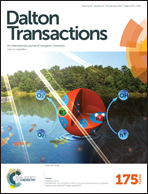Novel Anderson-type [TeMo6O24]6−-based metal–organic complexes tuned by different species and their coordination modes: assembly, various architectures and properties†
Abstract
Four novel Anderson-type polyoxometalates (POMs) [TeMo6O24]6− (TeMo6)-based metal–organic complexes (MOCs), namely, H2[Zn4(3-Hdpyp)2(TeMo6O24)2(H2O)16]·6H2O (1), [Zn3(3-dpyb)2(TeMo6O24)(H2O)12]·8H2O (2), [Cu2(4-Hdpyp)2(TeMo6O24)(H2O)6]·4H2O (3), and [Cu3(3-dpyp)2(TeMo6O24)(H2O)8]·4H2O (4) (3-dpyp = N,N′-bis(3-pyridinecarboxamide)-1,3-propane, 3-dpyb = N,N′-bis(3-pyridinecarboxamide)-1,4-butane, 4-dpyp = N,N′-bis(4-pyridinecarboxamide)-1,3-propane), were hydrothermally synthesized and structurally characterized by single-crystal X-ray diffraction, IR spectra, powder X-ray diffraction (PXRD) and thermogravimetric analyses (TGA). In complex 1, two TeMo6 polyoxoanions bridge ZnII ions to generate a discrete tetranuclear zinc complex H2[Zn4(3-Hdpyp)2(TeMo6O24)2(H2O)16]. In 2, the TeMo6 anions connect the metal–organic units [Zn3(3-dpyb)2]6+ to form an Anderson-type TeMo6-based wave-like metal–organic chain. Both the discrete tetranuclear subunits in 1 and 1D wavy chains in 2 were further extended to 2D supramolecular networks through the hydrogen bonding interactions. In complex 3, the TeMo6 anions link the metal–organic units [Cu2(4-Hdpyp)2]6+ to construct a 2D layer, which is further extended to a 3D supramolecular framework by the hydrogen bonding interactions. In complex 4, the TeMo6 polyoxoanions bridge the CuII ions to generate a 2D Cu-TeMo6 inorganic layer, which is further linked by the μ2-bridging 3-dpyp ligands to form a 3D metal–organic framework. The effects of various coordination modes of TeMo6 polyanions and the bis-pyridyl-bis-amide ligands, as well as the central metals on the structures of the title complexes have been discussed. Besides, the fluorescence, electrochemical properties and photocatalytic activities of the title complexes have been investigated in detail.
![Graphical abstract: Novel Anderson-type [TeMo6O24]6−-based metal–organic complexes tuned by different species and their coordination modes: assembly, various architectures and properties](/en/Image/Get?imageInfo.ImageType=GA&imageInfo.ImageIdentifier.ManuscriptID=C5DT04074D&imageInfo.ImageIdentifier.Year=2016)

 Please wait while we load your content...
Please wait while we load your content...